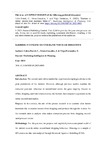Mostrar o rexistro simple do ítem
Barriers to Online Second-Hand Purchase Behavior
| dc.contributor.author | Calvo-Porral, Cristina | |
| dc.contributor.author | Orosa, Javier | |
| dc.contributor.author | Viejo-Fernández, Nuria | |
| dc.date.accessioned | 2023-12-29T12:47:47Z | |
| dc.date.available | 2023-12-29T12:47:47Z | |
| dc.date.issued | 2023 | |
| dc.identifier.citation | Calvo-Porral, C., Orosa-González, J. and Viejo-Fernández, N. (2024), "Barriers to online second-hand purchase behavior", Marketing Intelligence & Planning, Vol. 42 No. 2, pp. 213-233. https://doi.org/10.1108/MIP-03-2023-0093 | |
| dc.identifier.issn | 0263-4503 | |
| dc.identifier.uri | http://hdl.handle.net/2183/34721 | |
| dc.description | This version of the article has been accepted for publication, after peer review, but is not the Version of Record and does not reflect post-acceptance improvements, or any corrections. The Version of Record is available online at: https://doi.org/10.1108/MIP-03-2023-0093 | es_ES |
| dc.description.abstract | [Abstract] Introduction: The second-hand online market has experienced a rapid growth due to the great penetration of the internet. However, although previous studies examine the consumer purchase behaviour in second-hand stores, the great majority focuses on offline shopping, and little is known about the barriers that consumers experience in the online second-hand market. Purpose: In this context, the aim of the present research is to examine what factors determine that consumers restrain from shopping used products through the internet. So, this research aims to analyse what makes consumers prevent from shopping second-hand products online. Methodology: For this purpose, we propose and empirically test a conceptual model of the barriers towards online second-hand shopping behaviour. Drawing on a sample of 405 consumers data was analyzed through Structural Equation Modelling (SEM). Findings: Our findings reveal that contamination effects and the lack of trust towards the online store, followed by the low perceived product reliability and the poor product perceived quality prevent consumers from shopping used products online. Conversely, consumer embarrassment for shopping second-hand products and the purchase uncertainty do not influence consumers’ second-hand shopping behaviour. Value: This study contributes to the marketing literature on second-hand shopping, being an attempt to explore the factors that prevent consumers from purchasing used products through the internet. | es_ES |
| dc.language.iso | eng | es_ES |
| dc.publisher | Emerald | es_ES |
| dc.relation.isversionof | https://doi.org/10.1108/MIP-03-2023-0093 | |
| dc.relation.uri | https://doi.org/10.1108/MIP-03-2023-0093 | es_ES |
| dc.rights | © 2023, Emerald Publishing Limited. This AAM is provided for your own personal use only. It may not be used for resale, reprinting, systematic distribution, emailing, or for any other commercial purpose without the permission of the publisher. | es_ES |
| dc.subject | Second-hand products | es_ES |
| dc.subject | Barriers | es_ES |
| dc.subject | Purchase behaviour | es_ES |
| dc.subject | Online shopping | es_ES |
| dc.title | Barriers to Online Second-Hand Purchase Behavior | es_ES |
| dc.type | info:eu-repo/semantics/article | es_ES |
| dc.rights.access | info:eu-repo/semantics/openAccess | es_ES |
| UDC.journalTitle | Marketing Intelligence & Planning | es_ES |
| UDC.volume | 42 | |
| UDC.issue | 2 | |
| UDC.startPage | 213 | |
| UDC.endPage | 233 | |
| dc.identifier.doi | https://doi.org/10.1108/MIP-03-2023-0093 |
Ficheiros no ítem
Este ítem aparece na(s) seguinte(s) colección(s)
-
GI-C+D - Artigos [106]






